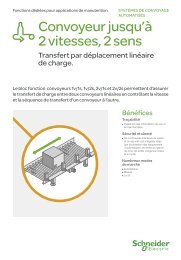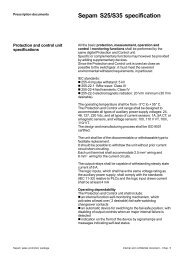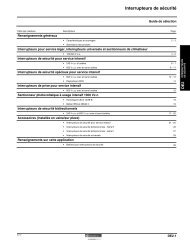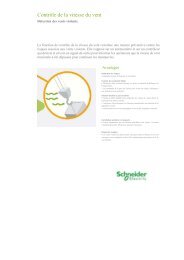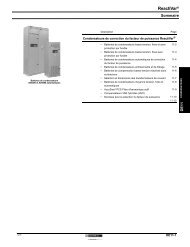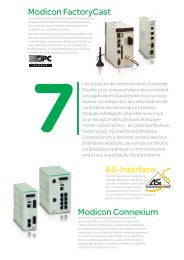3000DB0902 ZSI Application Note - Schneider Electric
3000DB0902 ZSI Application Note - Schneider Electric
3000DB0902 ZSI Application Note - Schneider Electric
Create successful ePaper yourself
Turn your PDF publications into a flip-book with our unique Google optimized e-Paper software.
Data Bulletin<br />
<strong>3000DB0902</strong><br />
05/2009<br />
LaVergne, TN, USA<br />
Sepam <strong>ZSI</strong> <strong>Application</strong> <strong>Note</strong><br />
Class Number 3000<br />
What is <strong>ZSI</strong>?<br />
Zone Selective Interlocking (<strong>ZSI</strong>) is a communication-based protection<br />
scheme built into the firmware of the SEPAM MV protective relays. The<br />
basic idea involves a downstream breaker sending a blocking signal to an<br />
upstream breaker. The blocking signal blocks a high(er) speed tripping<br />
element.<br />
All devices within the <strong>ZSI</strong> system have backup elements which are<br />
independent of the high speed scheme. The normal result of a <strong>ZSI</strong> system<br />
for through faults is the high speed elements are blocked and standard time<br />
overcurrent elements are ready to provide backup protection. If the fault is<br />
internal to the <strong>ZSI</strong> zone, a high speed (typically 100-200ms) trip will occur.<br />
Refer to Figure 1 and Figure 2 below.<br />
Figure 1: Fault Downstream of F1 Figure 2: Fault Upstream of F1<br />
Communication is done via inputs and outputs on the SEPAM relay at<br />
control power voltage (typically 125Vdc or 110Vac), and not by low millivolt<br />
signals susceptible to noise. The inputs and outputs represent almost no<br />
burden, blocking signal distances of ½ mile show very little voltage drop<br />
(with 125Vdc control power).<br />
<strong>ZSI</strong> in its simplest form (Figures 1 and 2) provides the basic idea of the<br />
scheme, however this idea can be expanded to use multiple feeders (Figure<br />
3), multiple mains and a tie breaker (Figures 5 and 5a), and a complex ring<br />
bus arrangement (Figure 6).<br />
The purpose of this paper is to provide a thorough understanding of the <strong>ZSI</strong><br />
scheme so an engineer can design, wire and program the SEPAM relays<br />
(with SFT2841 software).<br />
© 2009 <strong>Schneider</strong> <strong>Electric</strong> All Rights Reserved
Sepam <strong>ZSI</strong> <strong>Application</strong> <strong>Note</strong> <strong>3000DB0902</strong><br />
05/2009<br />
Why use <strong>ZSI</strong>?<br />
The primary use of <strong>ZSI</strong> is the ability to trip faster than the normal overcurrent<br />
(ANSI 50/51 elements) coordinating interval. The result of tripping faster is<br />
significant reduction of arc flash energy. This reduction is at the expense of<br />
a couple of control wires per circuit; however it is NOT at the expense of<br />
coordination.<br />
Below is a table that indicates the AF energy for 5kA, 10kA, 20kA, 30kA and<br />
50kA bolted three phase faults at voltage levels of 4160V and 13.8kV.<br />
Table 1:<br />
Arc Flash Results for a 100ms <strong>ZSI</strong> system<br />
Bus Name<br />
kH represents<br />
bolted 3PH<br />
fault current<br />
Protective<br />
Device<br />
Name<br />
Bus<br />
kV<br />
Bus<br />
Bolted<br />
Fault<br />
(kA)<br />
Prot<br />
Dev<br />
Bolted<br />
Fault<br />
Prot Dev<br />
Arcing<br />
Fault<br />
(kA)<br />
Trip/<br />
Delay<br />
Time<br />
(sec.)<br />
Breaker<br />
Opening<br />
Time<br />
(sec.)<br />
Ground Equip<br />
Type<br />
Arc Flash Working Incident<br />
Gap<br />
BoundaryDistance<br />
Energy<br />
(mm)<br />
(in) (in) (cal/cm2)<br />
Required<br />
Protective<br />
FR<br />
Clothing<br />
4160V_5kA <strong>ZSI</strong>_0.1_5kA 4.16 5 5 4.91 0.1 0.083 Yes SWG 104 29 36 0.96 Category 0<br />
4160V_10kA <strong>ZSI</strong>_0.1_10kA 4.16 10 10 9.71 0.1 0.083 Yes SWG 104 62 36 2 Category 1<br />
4160V_20kA <strong>ZSI</strong>_0.1_20kA 4.16 20 20 19.18 0.1 0.083 Yes SWG 104 131 36 4.2 Category 2<br />
4160V_30kA <strong>ZSI</strong>_0.1_30kA 4.16 30 30 28.58 0.1 0.083 Yes SWG 104 204 36 6.5 Category 2<br />
4160V_50kA <strong>ZSI</strong>_0.1_50kA 4.16 50 50 47.21 0.1 0.083 Yes SWG 104 357 36 11 Category 3<br />
13800V_5kA <strong>ZSI</strong> 0.1_5kA 13.8 5 5 4.91 0.1 0.083 Yes SWG 153 33 36 1.1 Category 0<br />
13800V_10kA <strong>ZSI</strong> 0.1_10kA 13.8 10 10 9.71 0.1 0.083 Yes SWG 153 70 36 2.3 Category 1<br />
13800V_20kA <strong>ZSI</strong> 0.1_20kA 13.8 20 20 19.18 0.1 0.083 Yes SWG 153 149 36 4.8 Category 2<br />
13800V_30kA <strong>ZSI</strong> 0.1_30kA 13.8 30 30 28.58 0.1 0.083 Yes SWG 153 232 36 7.3 Category 2<br />
13800V_50kA <strong>ZSI</strong> 0.1_50kA 13.8 49.99 49.99 47.21 0.1 0.083 Yes SWG 153 405 36 13 Category 3<br />
Table 2:<br />
Arc Flash Results for a 200ms <strong>ZSI</strong> system<br />
Bus Name<br />
Protective<br />
Device<br />
Name<br />
Bus<br />
kV<br />
Bus<br />
Bolted<br />
Fault<br />
(kA)<br />
Prot Dev<br />
Bolted<br />
Fault<br />
(kA)<br />
Prot Dev<br />
Arcing<br />
Fault<br />
(kA)<br />
Trip/<br />
Delay<br />
Time<br />
(sec.)<br />
Breaker<br />
Opening<br />
Time<br />
(sec.)<br />
Ground Equip<br />
Type<br />
Arc Flash Working Incident<br />
Gap<br />
Boundary Distance Energy<br />
(mm)<br />
(in) (in) (cal/cm2)<br />
Required<br />
Protective<br />
FR Clothing<br />
Category<br />
A_4160V_5kA <strong>ZSI</strong>_0.2_5kA 4.16 5 5 4.91 0.2 0.083 Yes SWG 104 45 36 1.5 Category 1<br />
B_4160V_10kA <strong>ZSI</strong>_0.2_10kA 4.16 10 10 9.71 0.2 0.083 Yes SWG 104 96 36 3.1 Category 1<br />
C_4160V_20kA <strong>ZSI</strong>_0.2_20kA 4.16 20 20 19.18 0.2 0.083 Yes SWG 104 205 36 6.5 Category 2<br />
D_4160V_30kA <strong>ZSI</strong>_0.2_30kA 4.16 30 30 28.58 0.2 0.083 Yes SWG 104 320 36 10 Category 3<br />
E_4160V_50kA <strong>ZSI</strong>_0.2_50kA 4.16 50 50 47.21 0.2 0.083 Yes SWG 104 558 36 17 Category 3<br />
F_13800V_5kA <strong>ZSI</strong> 0.2 5kA 13.80 5 5 4.91 0.2 0.083 Yes SWG 153 51 36 1.7 Category 1<br />
G_13800V_10kA <strong>ZSI</strong> 0.2 10kA 13.80 10 10 9.71 0.2 0.083 Yes SWG 153 109 36 3.5 Category 1<br />
H_13800V_20kA <strong>ZSI</strong> 0.2 20kA 13.80 20 20 19.18 0.2 0.083 Yes SWG 153 233 36 7.4 Category 2<br />
I_13800V_30kA <strong>ZSI</strong> 0.2 30kA 13.80 30 30 28.58 0.2 0.083 Yes SWG 153 363 36 11 Category 3<br />
J_13800V_50kA <strong>ZSI</strong> 0.2 50kA 13.80 49.99 49.99 47.21 0.2 0.083 Yes SWG 153 634 36 19 Category 3<br />
Most 4160V systems have bolted three phase fault currents less than 20-<br />
30kA. From the table the incident energies are 4.2 and 6.5 cal/cm 2 , both of<br />
these results in Cat 2 PPE.<br />
A 10MVA base rated, 6% impedance transformer has an infinite bus let<br />
through of 23,131A at 4160V. A 25MVA base rated, 6% impedance<br />
transformer has an infinite bus let through of 17,432A at 13.8kV. Most<br />
industrial applications have 5kV buses that are fed from transformers<br />
smaller than 10MVA and 15kV buses smaller than 25MVA. The conclusion<br />
is that for most industrial applications, the <strong>ZSI</strong> will limit the AF energies to<br />
CAT 2 or below.<br />
If AF reduction is the main desire in a normal system design, the<br />
conventional bus differential relay (87B) will typically have an AF category of<br />
2<br />
© 2009 <strong>Schneider</strong> <strong>Electric</strong> All Rights Reserved
<strong>3000DB0902</strong><br />
05/2009<br />
Sepam <strong>ZSI</strong> <strong>Application</strong> <strong>Note</strong><br />
zero. The differential requires dedicated ct’s all sized the same. In this<br />
respect the 87B and the <strong>ZSI</strong> do not “compete”. However, if the fault currents<br />
are limited to values that are below a desired AF category, or if there is an<br />
existing lineup of switchgear that requires AF reduction, the <strong>ZSI</strong> becomes a<br />
very cost-effective solution.<br />
The <strong>ZSI</strong> scheme can be cascaded, without the need for coordination. One<br />
“zone” may include the main bus of a switchgear lineup, another zone may<br />
include a feeder breaker that has a conductor run of 2000 feet. Each of<br />
these zones can have <strong>ZSI</strong> time delays of 100-200ms. If a fault does occur in<br />
the 2000 foot run of cable, the feeder that feeds the fault would block the<br />
main <strong>ZSI</strong> from tripping high speed, the feeder would not receive a blocking<br />
signal from the breaker that the conductor terminates into, and therefore<br />
would trip high speed.<br />
Where is <strong>ZSI</strong> used?<br />
Square D Company began developing low voltage (LV -480 volt) <strong>ZSI</strong><br />
technology in 1986, and began using <strong>ZSI</strong> extensively in 480 volt substations<br />
in 1988. At that time the term “Arc Flash” was virtually unknown, and the<br />
electrical phenomena that dominated the trade magazines was the effects<br />
of harmonic distortion on the power system.<br />
The application of the 480 volt <strong>ZSI</strong> is almost identical to the MV design.<br />
Most people believe the MV design is easier to troubleshoot. This stems<br />
from the inherent information available in modern day digital relays versus<br />
the low-voltage trip units where virtually none exist.<br />
The most recent application of <strong>ZSI</strong> is between LV trip units and MV relays.<br />
Refer to Figure 7. A complete technical paper written by Van Wagner is also<br />
included in the Appendix.<br />
<strong>ZSI</strong> is used in the following MV applications:<br />
• Only within an MV lineup of switchgear (provides high-speed trip for bus<br />
fault). Refer to Figures 3, 5 and 5a.<br />
• Between separated radial MV lineups of switchgear (provides highspeed<br />
trip for conductor fault). This scheme trips one breaker and<br />
removes service to all loads downstream of a tripped breaker. Refer to<br />
Figure 4.<br />
• Between separated looped MV lineups of switchgear (provides highspeed<br />
trip for conductor fault). This scheme trips two breakers to clear<br />
fault, but maintains service to other loads. Refer to Figure 6.<br />
• LV trip units to “virtual” 480V device (MV Relay) (provides AF<br />
improvement by tripping MV feeder breaker). Refer to Figure 7.<br />
© 2009 <strong>Schneider</strong> <strong>Electric</strong> All Rights Reserved 3
Sepam <strong>ZSI</strong> <strong>Application</strong> <strong>Note</strong> <strong>3000DB0902</strong><br />
05/2009<br />
Figure 3:<br />
MV application of <strong>ZSI</strong> within the lineup<br />
Figure 4:<br />
Radial <strong>ZSI</strong> <strong>Application</strong> for high speed line protection<br />
52<br />
52<br />
4<br />
© 2009 <strong>Schneider</strong> <strong>Electric</strong> All Rights Reserved
<strong>3000DB0902</strong><br />
05/2009<br />
Sepam <strong>ZSI</strong> <strong>Application</strong> <strong>Note</strong><br />
Figure 5:<br />
MV application of <strong>ZSI</strong> M-T-M<br />
Figure 5a:<br />
Alternate MV application of <strong>ZSI</strong> M-T-M (Non-relayed Tie)<br />
© 2009 <strong>Schneider</strong> <strong>Electric</strong> All Rights Reserved 5
Sepam <strong>ZSI</strong> <strong>Application</strong> <strong>Note</strong> <strong>3000DB0902</strong><br />
05/2009<br />
Figure 6:<br />
Closed Loop / Ring Bus <strong>Application</strong><br />
6<br />
© 2009 <strong>Schneider</strong> <strong>Electric</strong> All Rights Reserved
<strong>3000DB0902</strong><br />
05/2009<br />
Sepam <strong>ZSI</strong> <strong>Application</strong> <strong>Note</strong><br />
Figure 7:<br />
Low Voltage MicroLogic trip units supply blocking signals to<br />
“virtual” main with SEPAM relay<br />
© 2009 <strong>Schneider</strong> <strong>Electric</strong> All Rights Reserved 7
Sepam <strong>ZSI</strong> <strong>Application</strong> <strong>Note</strong> <strong>3000DB0902</strong><br />
05/2009<br />
MV <strong>Application</strong>s<br />
<strong>Application</strong> 1 – Simple Main / Feeder <strong>ZSI</strong><br />
Figure shows the control diagram for the main breaker shown in Figure 3, a<br />
single main with two feeders. The main breaker receives two contacts, O3<br />
from the SEPAM relay connected to Fdr 1 and O3 from the SEPAM relay<br />
connected to Fdr 2. If either one of these contacts close, then I13 (the input<br />
on the SEPAM relay connected to the main breaker) would activate blocking<br />
of the high speed <strong>ZSI</strong> scheme and the main would not trip the <strong>ZSI</strong> element.<br />
Figure 8:<br />
Main Bkr Control Diagram for a single main and two feeder<br />
system in Figure 3..<br />
Figure 9 shows the SFT2841 Program Logic settings for the Main and<br />
Figure 9a shows the SFT2841 protection settings for the feeders.<br />
8<br />
© 2009 <strong>Schneider</strong> <strong>Electric</strong> All Rights Reserved
<strong>3000DB0902</strong><br />
05/2009<br />
Sepam <strong>ZSI</strong> <strong>Application</strong> <strong>Note</strong><br />
Figure 9:<br />
SFT2841 Program Logic Settings for Main<br />
I13 accepts the blocking contacts from feeders<br />
I11 accepts the 52b contact<br />
I12 accepts the 52a contact<br />
Figure 9a:<br />
SFT2841 Program Logic Settings for Feeders (also see Figure<br />
11a) which only require an output assignment, in this case O3.<br />
Figure 10 shows the SFT2841 protection settings for the Main and Figure<br />
10a shows the SFT2841 protection settings for the feeders.<br />
© 2009 <strong>Schneider</strong> <strong>Electric</strong> All Rights Reserved 9
Sepam <strong>ZSI</strong> <strong>Application</strong> <strong>Note</strong> <strong>3000DB0902</strong><br />
05/2009<br />
Figure 10: SFT2841 protection settings for the Main (only Elements 1<br />
and 3 are need for both <strong>ZSI</strong> and the backup Time-based 51<br />
setting).<br />
Figure 10a: SFT2841 protection settings for the Feeders<br />
Keep in mind that the last relay in the <strong>ZSI</strong> scheme blocks ONLY. The<br />
tripping for this position in the <strong>ZSI</strong> scheme is performed by the standard<br />
50/51 elements.<br />
Figure 11: SFT2841 Control Matrix for the Main<br />
10<br />
© 2009 <strong>Schneider</strong> <strong>Electric</strong> All Rights Reserved
<strong>3000DB0902</strong><br />
05/2009<br />
Sepam <strong>ZSI</strong> <strong>Application</strong> <strong>Note</strong><br />
Figure 11a: SFT2841 Control Matrix for the Feeders<br />
Recommended outputs for <strong>ZSI</strong>:<br />
Series 20/40 – O3 and O12 (if needed)<br />
Series 80 – O102 (Block Direction 1), O103 (Block Direction 2)<br />
These recommended output assignments are made to avoid a conflict with<br />
other frequently used assignments. Worth mentioning is the “remote close<br />
via communication”, this function is pre-programmed in the Series 20/40 as<br />
O11, in the Series 80 it is O3. This is believed to be an ever increasing<br />
application because it allows circuit breakers to be closed without an<br />
operator standing in front of the switchgear. Presently there is a demand for<br />
the Square D Field Services designed remote open/close and racking<br />
device.<br />
Recommended inputs for <strong>ZSI</strong>:<br />
Series 20/40 – I13 (Direction 1 – Series 20 only has 1 direction)<br />
Series 40 – I21 (Direction 2)<br />
Series 80 – I104 (Direction 1), I105 (Direction 2)<br />
NOTE: A further discussion on the meaning of “direction” is included in the<br />
application of the closed ring.<br />
General Procedure:<br />
1. Wire I/O<br />
2. Configure Program Logic page<br />
3. Configure Control Matrix<br />
4. Configure Protection Tab which includes<br />
a. <strong>ZSI</strong> settings<br />
b. Phase Over current settings<br />
c. Ground Over Current settings<br />
© 2009 <strong>Schneider</strong> <strong>Electric</strong> All Rights Reserved 11
Sepam <strong>ZSI</strong> <strong>Application</strong> <strong>Note</strong> <strong>3000DB0902</strong><br />
05/2009<br />
The <strong>ZSI</strong> scheme requires specific settings for the main and feeders. It is<br />
common for application engineers to set the <strong>ZSI</strong> (phase) pickup setting per<br />
Table 3 below:<br />
Table 3:<br />
<strong>ZSI</strong> “Common” Pickup Settings for Blocking to Occur<br />
Switchgear Main Bus Min. PU * Max PU<br />
1200A 2.4-3.6kA ½ maximum three phase fault current.<br />
2000A 4-6kA ½ maximum three phase fault current.<br />
3000A 6-9kA ½ maximum three phase fault current.<br />
*Min. PU assumes that the short circuit contribution from motors is less than<br />
the pickup value. If there is a system that has a significant motor<br />
contribution in the <strong>ZSI</strong> zone, perform the following steps:<br />
Increase the time delay of the scheme to 200ms.<br />
Use directional 67 element (pointing in the forward direction) to block<br />
only if the fault is downstream of the feeder. The motor contribution<br />
would be in the reverse direction.<br />
Within a given scheme, all relays typically have the same pickup. The<br />
ground fault <strong>ZSI</strong> pickups are commonly set to 50-87% of the phase settings<br />
for a solidly grounded system. The common time delays are 100ms. As<br />
mentioned above, there may be instances where motor contribution at one<br />
level of the <strong>ZSI</strong> may cause the time delay to be 200ms and the time delays<br />
near the utility to be 100ms (the SEPAM instruction book shows this<br />
example).<br />
Protection for most industrial feeder breakers typically allow for a ANSI 50<br />
function (instantaneous). In the example above, the <strong>ZSI</strong> blocking is set up to<br />
2.4kA and the feeder breakers also trip at 2.4kA. The feeder 50 setting is<br />
typically set to1.7 x maximum inrush. So if there is a fault downstream of the<br />
feeder of 3000A, the feeder would send a blocking signal to the main and<br />
simultaneously trip the feeder. Once the trip signal is sent to the feeder, the<br />
blocking signal is released 200 ms later. If the feeder breaker did not clear<br />
the fault (i.e. failed to operate), the main would immediately trip to clear the<br />
fault. Therefore the <strong>ZSI</strong> scheme has a built-in breaker failure protection.<br />
If a feeder feeds multiple transformers and an ANSI 50 element is not used,<br />
the downstream 3000A fault would be allowed to flow until the feeder 51<br />
element cleared (if a downstream transformer primary fuse did not clear the<br />
fault). If this were the case, the feeder would send and maintain the blocking<br />
signal and the main would not trip on the high speed element. The feeder 51<br />
element would eventually trip (based on its setting).<br />
<strong>Application</strong> 2 – Main-Tie-Main The normal Main-Tie-Main (M-T-M) is very common to <strong>Application</strong> 1<br />
covered in detail above. In the M-T-M, the feeders have a second output<br />
contact to block the TIE (O12 refer to Figure 12). All settings for the feeder<br />
are the same. The TIE and Main settings in the M-T-M are just like the Main<br />
in <strong>Application</strong> 1. TIE is slightly different in that it blocks both Mains (O12<br />
blocks M1 and O3 blocks M2); the <strong>ZSI</strong> pickup and time delay settings are<br />
the same as the Main.<br />
12<br />
© 2009 <strong>Schneider</strong> <strong>Electric</strong> All Rights Reserved
<strong>3000DB0902</strong><br />
05/2009<br />
Sepam <strong>ZSI</strong> <strong>Application</strong> <strong>Note</strong><br />
Figure 12:<br />
M-T-M <strong>ZSI</strong> with I/O labeled for SEPAM Series 20/40 with I/O<br />
assignments.<br />
In Figure 12 assume the TIE is closed and M2 is Open.<br />
Table 4:<br />
SC1, SC2 & SC3 Block and Trip Summary<br />
Short Circuit Event CB Blocked / Blocked By / Output Contact Trip<br />
SC1 TIE / F4 / O12 and M1 / TIE / O12 F4<br />
SC2 M1 / TIE / O12 TIE<br />
SC3 NONE M1<br />
<strong>Note</strong> that in “SC1 and SC2” the TIE breaker sends a blocking signal to M2<br />
but in these cases this breaker is already open. If the N.O. TIE is closed<br />
then either M1 or M2 must be open. With this scheme, there is no need to<br />
write Boolean logic. Blocking both mains works well for this situation. If the<br />
TIE is NC, then this configuration would be considered a “closed loop” which<br />
is covered in the next application example.<br />
© 2009 <strong>Schneider</strong> <strong>Electric</strong> All Rights Reserved 13
Sepam <strong>ZSI</strong> <strong>Application</strong> <strong>Note</strong> <strong>3000DB0902</strong><br />
05/2009<br />
<strong>Application</strong> 3 – Closed Loop System Refer to Figure 6 and Figure 13.<br />
Figure 13: Closed Loop <strong>ZSI</strong> with I/O assignments<br />
The closed loop system is a system that has multiple sources that are<br />
normally tied together. This could be the case with a facility that has two<br />
separate utility feeds (most common), or a system that has one utility feed<br />
and one or more generators (common in paper mills).<br />
The benefits of this scheme are commonly used in the “critical power” area.<br />
This scheme requires a more thorough knowledge of all the power system<br />
disciplines. Special care is required when multiple sources are tied together<br />
to make certain the switchgear interrupting ratings are adequate and that<br />
reverse current relays (ANSI 67 and 67N) elements are properly applied<br />
and tested. This scheme also requires a higher level of safety training for<br />
operators and technicians. When a circuit breaker is opened in the loop, it is<br />
more likely than not that the line and load side of the breaker is still hot.<br />
The basis of the closed loop <strong>ZSI</strong> is that within the portion of the system that<br />
is closed, each relay has two 67 elements; one looking in the forward<br />
direction and one looking in the reverse (Figure 13). The 67 Element 1 (67-<br />
1) is typically pointing in the reverse direction. The convention for choosing<br />
the direction for the relays in the system is somewhat arbitrary. Following a<br />
14<br />
© 2009 <strong>Schneider</strong> <strong>Electric</strong> All Rights Reserved
<strong>3000DB0902</strong><br />
05/2009<br />
Sepam <strong>ZSI</strong> <strong>Application</strong> <strong>Note</strong><br />
consistent convention is recommended. Below is convention that has<br />
worked well:<br />
1. Choose all 67-1 directional elements in the reverse direction of normal<br />
current flow (into non-polarity, out of the polarity marks on the CT). 67-2<br />
is always in the opposite direction as 67-1.<br />
2. Eventually there are feeder breakers that are not in the “closed loop” (i.e.<br />
they cannot produce a constant source of fault current) these feeders do<br />
not require 67 elements; the non-directional 50 settings work fine<br />
(unless the motor contribution is in excess of the desired pickup value).<br />
3. The I/O are associated with a specific direction.<br />
a. Series 80 Inputs:I 104-Rev; I105- Fwd<br />
b. Series 80 Outputs: O102, O104*, O106* - Rev<br />
O103, O105*, O107* - Fwd<br />
c. Series 40 Inputs: I13 – Rev; I21 - Fwd<br />
d. Series 40 Outputs:O3, O12* - Rev<br />
O13, O14 – Fwd<br />
* = If needed.<br />
Direction 1 corresponds with “Rev”. Direction 2 corresponds with “Fwd”<br />
4. Figure 13 output contacts also have arrowheads indicating which 67<br />
element they work in conjunction with. Since blocking is always<br />
“backwards”, the arrowhead of an output contact never points toward an<br />
input, but instead it will always point away from an input. Study Figure 13<br />
and follow the blocking contacts for a 67-1 element and a 67-2 element.<br />
In the examples for Figures 14-15 it is assumed that the Mains and Ties<br />
have Series 80 SEPAM relays and the feeders have Series 40.<br />
Short Circuit Events (SC1 and SC2 in the closed loop system)<br />
SC1 – refer to Figure 14<br />
F2a does not have dual 67 elements since it has been determined that the<br />
load downstream of F2a does not have either a generator, utility or large<br />
motor contribution. The non-directional element at F2a would block (via O3<br />
and O12) TIE-a and M2a elements that can provide fault current to F2a. F2a<br />
would trip on it’s time based 50/51 setting.<br />
Table 5: SC1 Block and Trip Summary<br />
Short Circuit Event CB Blocked / Blocked By / Output Contact Trip<br />
SC1 TIE-a and M2a / F2a / O12 and O3 F2a<br />
F2 / M2a / O103<br />
M1a / TIE-a / O103<br />
F1 / M1a / O103<br />
TIE and M2 / F2 / O14 and O13<br />
TIE and M1 / F1 / O14 and O13<br />
All the breakers in this example are blocked from high speed tripping except<br />
F1a (which does not see the fault) and F2a which trips.<br />
A 67 element will not trip if either of the following is true:<br />
It is blocked by a downstream relay that also sees the fault in the proper<br />
direction.<br />
The fault is not in the direction of the element.<br />
© 2009 <strong>Schneider</strong> <strong>Electric</strong> All Rights Reserved 15
Sepam <strong>ZSI</strong> <strong>Application</strong> <strong>Note</strong> <strong>3000DB0902</strong><br />
05/2009<br />
Figure 14:<br />
Fault Example SC1<br />
SC-2 Refer to Figure 15.<br />
When a fault is detected by a directional element, the <strong>ZSI</strong> blocks backwards<br />
to the source breakers that can provide fault current in that direction. For<br />
fault SC2 the 67-2 element at F1 senses current in “its” direction and closes<br />
the two output contacts that match the forward direction, in this case O13<br />
and O14. These two contacts block the forward flowing element in M1 from<br />
tripping (67-2) and the TIE element 67-1. The 67-1 in M1 or 67-2 in the TIE<br />
does not see fault current in “their” direction. The TIE 67-1 element also<br />
blocks backwards which includes M2 67-2 and F2 67-1.<br />
16<br />
© 2009 <strong>Schneider</strong> <strong>Electric</strong> All Rights Reserved
<strong>3000DB0902</strong><br />
05/2009<br />
Sepam <strong>ZSI</strong> <strong>Application</strong> <strong>Note</strong><br />
Since the fault current coming in from M2 can split, some going through the<br />
TIE and some going through F2, M2a, TIE-a, M1a to fault, this loop must<br />
also be blocked. See the table below for complete blocking sequence.<br />
Table 6: SC2 Block and Trip Summary<br />
Short Circuit Event<br />
SC2<br />
CB Blocked / Blocked By / Output Contact Trip (Element)<br />
M1 and TIE / F1/ O13 and O14<br />
F1 does not receive blocking from M1a and Trips F1 (67-2)<br />
M2 and F2 / TIE / O102 and O104<br />
TIE and M2 / F2 / O14 and O13<br />
F2 / M2a / O103<br />
M1a does not receive blocking from F1 and Trips M1a (67-1)<br />
M2a / TIE-a / O102<br />
So the faulted line segment between breakers F1 and M1a is cleared<br />
quickly by the <strong>ZSI</strong> scheme and the rest of the load continues to operate.<br />
<strong>Note</strong> that some breakers are blocked more than once; the TIE is blocked by<br />
F1 and F2. The F2 block is in a direction that the TIE 67-2 element which is<br />
not picked up, so nothing occurs. Faults downstream of F2 could cause<br />
current to flow across the TIE in the 67-2 direction so this blocking is<br />
necessary.<br />
© 2009 <strong>Schneider</strong> <strong>Electric</strong> All Rights Reserved 17
Sepam <strong>ZSI</strong> <strong>Application</strong> <strong>Note</strong> <strong>3000DB0902</strong><br />
05/2009<br />
Figure 15:<br />
Fault Scenario SC2<br />
18<br />
© 2009 <strong>Schneider</strong> <strong>Electric</strong> All Rights Reserved
<strong>3000DB0902</strong><br />
05/2009<br />
Sepam <strong>ZSI</strong> <strong>Application</strong> <strong>Note</strong><br />
SEPAM SFT2841 Settings for Closed Loop <strong>ZSI</strong> Figure 16: Closed Loop <strong>ZSI</strong> Main and Tie 51 Settings<br />
In the closed loop system, the 67 elements (see Figure 17) perform the<br />
blocking and tripping functions, therefore only the backup time based 51<br />
settings are needed.<br />
Figure 17: Closed Loop <strong>ZSI</strong> Main and Tie 67 setting example.<br />
Figure 18:<br />
Closed Loop <strong>ZSI</strong> Control Matrix – Logic/Outputs<br />
Figure 19:<br />
Closed Loop <strong>ZSI</strong> Control Matrix – Protection/Outputs<br />
A subtle but important point is that the blocking assignments are made in<br />
the Logic/Output section of the control matrix, not the Protection/Outputs<br />
page (refer to Figures 18 and 19). The gray outputs are the outputs<br />
controlled by the “Circuit Breaker Control” (ON) setting.<br />
© 2009 <strong>Schneider</strong> <strong>Electric</strong> All Rights Reserved 19
Sepam <strong>ZSI</strong> <strong>Application</strong> <strong>Note</strong> <strong>3000DB0902</strong><br />
05/2009<br />
Figure 20: Series 40 Feeder in the Closed Loop <strong>ZSI</strong> - 51<br />
The feeders in the closed loop have the same setting philosophy, the 67<br />
elements block and trip and the 51 element is for backup (see Figures 20<br />
and 21).<br />
Figure 21: Series 40 Feeder in the Closed Loop <strong>ZSI</strong> – 67<br />
20<br />
© 2009 <strong>Schneider</strong> <strong>Electric</strong> All Rights Reserved
<strong>3000DB0902</strong><br />
05/2009<br />
Sepam <strong>ZSI</strong> <strong>Application</strong> <strong>Note</strong><br />
Control Diagram Figure 22: Control Diagram with “external” block sending and receiving<br />
A<br />
PTD<br />
1<br />
M7<br />
M8<br />
I13<br />
<strong>ZSI</strong> BLOCKING<br />
RECEPTION 1<br />
DL5C<br />
MES114<br />
S4D<br />
RTO<br />
13<br />
RTO<br />
14<br />
M1<br />
M2<br />
I11<br />
DL5C<br />
MES114<br />
S4D<br />
M4<br />
M5<br />
I12<br />
DL5C<br />
MES114<br />
S4D<br />
A1<br />
L(+)<br />
DL5C<br />
S40<br />
POWER<br />
SUPPLY<br />
RTO<br />
1<br />
RTO<br />
3<br />
125VDC<br />
SOURCE<br />
RTD<br />
5<br />
BLOCKING SIGNAL<br />
FROM T3-N-01 5069<br />
PO#24383883-007<br />
MAIN BREAKER<br />
RTD<br />
6<br />
53<br />
12<br />
13<br />
54<br />
RTN<br />
15<br />
SDL<br />
52<br />
/b<br />
RTN<br />
16<br />
56<br />
21<br />
22<br />
60<br />
RTN<br />
21<br />
SDL<br />
52/d<br />
RTN<br />
22<br />
N(-)<br />
A2<br />
0<br />
GRD<br />
G 10<br />
A10<br />
A11<br />
DL5C<br />
S4D<br />
03<br />
RTO<br />
2<br />
BLOCKING SIGNAL<br />
BREAKER 52-M1<br />
L5<br />
L6<br />
DL5C<br />
MES114<br />
012<br />
RTO<br />
4<br />
BLOCKING SIGNAL<br />
BREAKER 52-T<br />
B<br />
PTD<br />
2<br />
What is unique to this scheme in comparison to the M-T-M scheme is that<br />
care must be taken so that the two different lineups of switchgear do not tie<br />
DC power (typically 125Vdc) sources together.<br />
The convention used by the Square D Company switchgear plant in<br />
Smyrna, TN is to power the dry output contacts with the DC voltage from the<br />
“input” location. With this convention, the dry contacts are whetted at the<br />
location of the inputs. Refer to Figure 22.<br />
© 2009 <strong>Schneider</strong> <strong>Electric</strong> All Rights Reserved 21
Sepam <strong>ZSI</strong> <strong>Application</strong> <strong>Note</strong> <strong>3000DB0902</strong><br />
Data Bulletin 05/2009<br />
<strong>Schneider</strong> <strong>Electric</strong> USA<br />
Street Address<br />
City, State Zip Country<br />
1-888-SquareD (1-888-778-2733)<br />
www.schneider-electric.us<br />
Square D ® is a trademark or registered trademark of <strong>Schneider</strong> <strong>Electric</strong>. Other<br />
trademarks used herein are the property of their respective owners.<br />
<strong>Electric</strong>al equipment should be installed, operated, serviced, and maintained only by<br />
qualified personnel. No responsibility is assumed by <strong>Schneider</strong> <strong>Electric</strong> for any<br />
consequences arising out of the use of this material.<br />
22<br />
© 2009 <strong>Schneider</strong> <strong>Electric</strong> All Rights Reserved



